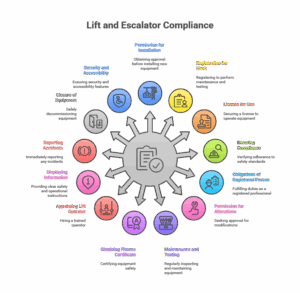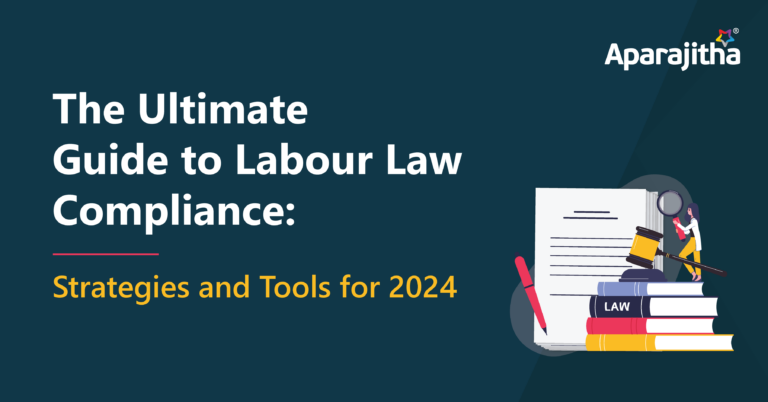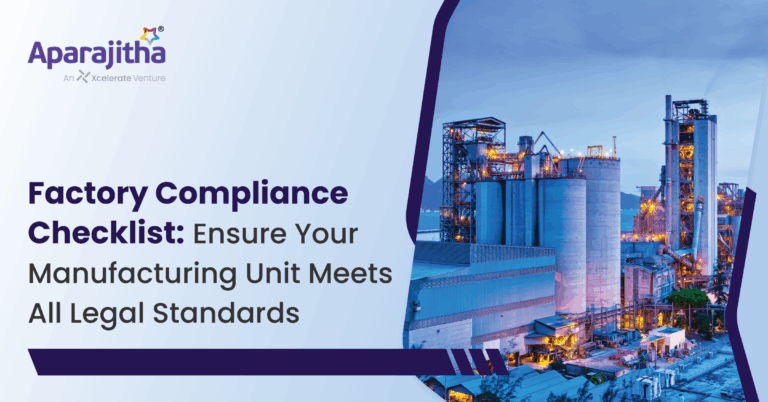Environment, Health, and Safety (“EHS”) laws play a vital role in safeguarding the environment, protecting public health, and ensuring safe working conditions across industries. Along with ensuring safe working conditions, compliance with EHS laws also create an overall safe environment with respect to any premises, majorly being occupied for commercial purposes. These regulations cover a broad spectrum of issues, including fire prevention, life safety measures, pollution control, hazardous waste management, and occupational health standards. However, ensuring full compliance with EHS laws can be complex, as they are governed by a wide array of Central and State legislations. One such important area under the EHS framework is the law governing lifts, escalators, elevators, moving walks, and passenger conveyors. The regulations of these machines are crucial in modern infrastructure where safety and operational compliance are of utmost importance.
The use of Lifts, Escalators, Elevators, Moving Walks or Passenger Conveyors have become increasingly common in urban India. From metropolitan cities to smaller towns, we can spot modern structural buildings like Residential Apartments, Hospitals, Shopping-Malls, Metro-Station, Bus-Terminals, Airport, Theatres, Workplace and other public places etc., equipped with these machines to facilitate easier transportation of people.
Given the crucial role as well as the number of lifts, escalators, moving walks or passenger conveyors in public, it is essential to comply with the regulatory framework in order to ensure public safety or the safety of its users. These large mechanical machines require precise installation and regular maintenance, any negligence can lead to serious accidents and may put human life at risk. To mitigate such risks, India has enacted comprehensive legislations to govern their installation, operation, maintenance, placing responsibilities and obligations on the owner, operator & manufactures, ultimately ensuring the safety.
Although India does not have a centralized regulation to govern lifts, escalators, moving walks or passenger conveyors, Part-8 Sec-5 of the National Building Code, 2016 exclusively lays regulatory guidelines for these machines. It mandates adherence with Indian standards (BIS), fire safety norms, relevant provisions of the Electricity Act, 2003, and various state-specific lift regulations and building codes. The law may slightly vary from state to state. In States or Union Territories where there are no specific laws governing lifts, compliance must align with the respective state’s Building Bye-laws. Some of the key safety standards, legal obligations and best practices governing Lifts are elaborated below:
- Permission for Erection/Installation
The owner or occupier intending to install any of these machines must submit an application to concerned state authority in manner prescribed under the relevant law, along with the requisite fees. Upon receipt of application, the Authorized Officer shall conduct the necessary enquiry and thereafter, may either allow or refuse the application. Only after obtaining the permit, can the applicant install such machines through the authorized person (as given under the concerned legislation), in compliance with relevant code of practices specified under BIS and the CEA (Measures relating to Safety and Electric Supply) Regulations, 2023. The installation must be completed within the period stipulated by the authority or the state rules, failing which the applicant will have to renew the permit granted. Upon completion, a completion report must be obtained from the registered person who carried out such installation/erection.
- Register to carry-out Entrusted Work
Any manufacturer, installer, or individual intending to undertake the erection, installation, or periodic testing and maintenance of these machines, must register with the Chief Inspector of Lifts and Escalators in the prescribed manner. Such person must ensure that the registration remains valid throughout, while undertaking such works. Failure to renew the registration may attract severe penalties, including imprisonment.
- License to Use Lifts, Escalator etc.
After the installation, the owner of any premises must make an application to the Inspector of Lifts in the prescribed form for the use of such machinery. The Inspector shall thereafter conduct an inspection and decide on the application. After the grant of the License, the Owner shall also ensure that it is renewed in a timely manner. However such renewal is subject to proper maintenance of the machines. Before granting renewal, the Inspector of Lifts may impose certain conditions for major modernization or recommended safety upgrades, if necessary.
- Maintenance, Inspection & Testing:
The owner of lifts, escalators, elevators, moving walks or passenger conveyors is obliged to maintain his machines in safe working conditions at all times, in consultation with the manufacturer. The machines must be inspected and tested periodically before first use, after major modifications, and at regular intervals by a competent person. The owner must ensure that any deficiencies identified are promptly rectified before resuming operations. A logbook must be maintained to record all maintenance, general servicing, repair work, testing, and inspections carried out.
- Obtain Fitness Certificate:
After inspection and testing, the owner, agent, or occupier must obtain a certificate of fitness from the competent person confirming that the lift, escalator, elevator, moving walk, or passenger conveyor is safe for operation.
Apart from obtaining licenses as mentioned above, the owner must ensure compliance with other regulatory frameworks such as maintaining the book of accounts, detailing the persons who have been entrusted the work regarding installation, maintenance of the work, records of permit, licenses and maintenance contracts entered into with regards to such machinery, appoint lift operator, display the minimum load capacity for passengers at a conspicuous location etc.
Non-Compliance may result in sealing of the lift or escalator and attract severe penalties. These may include imprisonment and/or fines. Continued contravention will lead to increased penalties, which may vary from state to state.
Operating and maintaining such equipment carries greater risks than commonly assumed. With the right compliance monitoring tools in place, organizations can ensure adherence to regulatory requirements and confidently face inspections by authorities.









2 Responses
Please call me back regarding the licence approval for lift.
Hi Team, stating a new position with real estate major as AVP Licenses & Approvals. I need better understanding of licenses and approvals required pre and post operations of commercial high rise building. This is an opportunity for both to formally work together i the future. You may reach me on my Mob: 9538319666. Please revert.